I haven't provided detailed commentary on the US labour market for a while now. To…
Australian labour market – strong recovery month but too early to withdraw the fiscal support
The latest data from the Australian Bureau of Statistics – Labour Force, Australia, February 2021 – released today (March 18, 2021), shows that the labour market has accelerated its pace of recovery from the pandemic recession. Employment increased by 0.7 per cent (88,700) in the month and unemployment fell by 69.900 to 805.2 thousand persons. As a result the unemployment rate fell by 0.5 points to 5.8 per cent, which with participation stable, is a good outcome. The main uncertainty now is that the recovery is still dependent on government fiscal support, which is due at the end of this month (March 2021). Given the labour market is still quite a margin from where it was in March 2020, the idea that the government would withdraw its fiscal support is not a compelling option. Overall, the recovery is still too slow and more government support by way of large-scale job creation is needed.
The summary ABS Labour Force (seasonally adjusted) estimates for February 2021 are:
- Employment increased 88.7 (0.7 per cent) – Full-time employment increased by 89,100 and part-time employment decreased by 500.
- Unemployment decreased 69.9 thousand to 805.2 thousand persons
- The official unemployment rate decreased 0.5 points to 5.8 per cent.
- The participation rate was steady at 66.1 per cent.
- Aggregate monthly hours worked increased 101.9 million hours (6.12 per cent) – strong rebound.
- Underemployment increased by 0.4 points to 8.5 per cent (a rise of 56.2 thousand). Overall there are 1,178,7 thousand underemployed workers. The total labour underutilisation rate (unemployment plus underemployment) decreased by 0.1 point to 14.4 per cent. There were a total of 1,982.9 thousand workers either unemployed or underemployed.
Employment rebounds strongly in February 2021
1. Employment growth was 0.6 per cent which represents are fairly robust monthly rebound.
It is now below the February 2020 level by just 1.8 thousand (-0.0 per cent).
2. Full-time employment increased by 89,100 and part-time employment decreased by 500.
3. So overall Australia is just about back to where it was before the pandemic hit, but only in aggregate terms. There are some sectors that are still languishing while others are rebounding strongly.
The following graph shows the month by month growth in full-time (blue columns), part-time (grey columns) and total employment (green line) for the 24 months to February 2021 using seasonally adjusted data.
The following table provides an accounting summary of the labour market performance over the last six months to provide a longer perspective that cuts through the monthly variability and provides a better assessment of the trends.
Assessment:
1. Total employment has risen by 468.8 thousand and 41.9 per cent of that increase has been in part-time work.
2. Full-time employment is still below the March level by 53.3 thousand.
Given the variation in the labour force estimates, it is sometimes useful to examine the Employment-to-Population ratio (%) because the underlying population estimates (denominator) are less cyclical and subject to variation than the labour force estimates. This is an alternative measure of the robustness of activity to the unemployment rate, which is sensitive to those labour force swings.
The following graph shows the Employment-to-Population ratio, since June 2008 (the low-point unemployment rate of the last cycle).
It fell with the onset of the GFC, recovered under the boost provided by the fiscal stimulus packages but then went backwards again as the Federal government imposed fiscal austerity in a hare-brained attempt at achieving a fiscal surplus in 2012.
The ratio rose by 0.4 points in February 2021 to 62.3 per cent on the back of strong employment growth. The ratio is now 0.6 points below pre-GFC peak in April 2008 of 62.9 per cent.
To put the current monthly performance into perspective, the following graph shows the average monthly employment change for the calendar years from 1980 to 2020 (to date).
1. The labour market weakened considerably over 2018 and that situation worsened in 2019.
2. The average employment change over 2020 was -7.5 thousand.
3. So far in 2021, the average monthly change is 59.1 thousand and you can see that from the graph that this is exceptional, although it has only been for two months so far.
The following graph shows the average monthly changes in Full-time and Part-time employment (lower panel) in thousands since 1980.
The interesting result is that during recessions or slow-downs, it is full-time employment that takes the bulk of the adjustment. Even when full-time employment growth is negative, part-time employment usually continues to grow.
However, this crisis is different because much of the employment losses are the result of lockdown and enforced business closures in sectors where part-time employment dominates.
But the slow recovery of full-time employment signals that the demand-side impacts from the lockdown have had wider effects.
State by State
In the past, I have shown the impact of the 120 day harsh lockdown in Victoria from June 2020. But since December, Victoria has been recovering strongly and has closed the gap with the other states.
It is now the second best performed state behind Queensland (on 0.2 points in it).
Hours worked increased 101.9 million hours (6.12 per cent) in February 2021
The recovery in hours worked as the various state lockdowns eased was strong this month.
Last month’s sharp fall appeared to be the result of an unseasonally large, seasonal exit to the beach and camping sites as a result of the pent-up holiday demand after the 2020 lockdowns.
The following graph shows the monthly growth (in per cent) over the last 24 months.
The dark linear line is a simple regression trend of the monthly change – which depicts a flat trend. Even before the coronavirus crisis struck, the trend was trending downwards (but will flatten a bit once the February exodus is reversed in subsequent months).
Unemployment decreased 69.9 thousand to 805.2 thousand persons
The official unemployment rate fell 0.5 points to 5.8 per cent as the rise in employment (88.7 thousand) vastly outstripped the rise in the labour force (18.8) with participation stable.
The following graph shows the national unemployment rate from February 1980 to February 2021. The longer time-series helps frame some perspective to what is happening at present.
Assessment:
1. There is still considerable slack in the labour market that could be absorbed with further fiscal stimulus. Unemployment remains 109,500 above the February 2020 level.
Broad labour underutilisation decreased by 0.1 points to 14.4 per cent in February 2021
The results for February 2021 are (seasonally adjusted):
1. Underemployment increased by 56.2 thousand.
2. The underemployment rate rose by 0.4 points to 8.5 per cent.
2. Overall there are 1,178.7 thousand underemployed workers.
3. The total labour underutilisation rate (unemployment plus underemployment) decreased by 0.1 points to 14.4 per cent all as a result of the decline in unemployment.
4. There were a total of 1,983.9 thousand workers either unemployed or underemployed.
The following graph plots the seasonally-adjusted underemployment rate in Australia from February 1980 to the February 2021 (blue line) and the broad underutilisation rate over the same period (green line).
The difference between the two lines is the unemployment rate.
The three cyclical peaks correspond to the 1982, 1991 recessions and the more recent downturn.
The other difference between now and the two earlier cycles is that the recovery triggered by the fiscal stimulus in 2008-09 did not persist and as soon as the ‘fiscal surplus’ fetish kicked in in 2012, things went backwards very quickly.
The two earlier peaks were sharp but steadily declined. The last peak fell away on the back of the stimulus but turned again when the stimulus was withdrawn.
With the participation steady this month, I expect no changes in hidden unemployment. Please read my blog post – Australian labour underutilisation rate is at least 13.4 per cent – for more discussion on this point.
Unemployment and broad labour underutilisation indexes – last four downturns
The following graph captures the evolution of the unemployment rates for the 1982, 1991, GFC and COVID-19 downturns.
For each episode, the graph begins at 100 – which is the index value of the unemployment rate at the low-point of each cycle (June 1981; December 1989; February 2008, and February 2020, respectively).
We then plot each episode out for 90 months.
For 1991, the peak unemployment which was achieved some 38 months after the downturn began and the resulting recovery was painfully slow. While the 1982 recession was severe the economy and the labour market was recovering by the 26th month. The pace of recovery for the 1982 once it began was faster than the recovery in the current period.
During the GFC crisis, the unemployment rate peaked after 16 months (thanks to a substantial fiscal stimulus) but then started rising again once the stimulus was prematurely withdrawn and a new peak occurred at the 80th month.
The COVID-19 downturn was obviously worse than any of the previous recessions shown but because of its unique nature – the job losses being largely driven by lockdowns etc.
But the recovery is evident.
The graph provides a graphical depiction of the speed at which each recession unfolded (which tells you something about each episode) and the length of time that the labour market deteriorated (expressed in terms of the unemployment rate).
After 11 months, the unemployment had risen from 100 to:
1. 125.9 index points in 1982 and rising.
2. 137.1 index points in 1991 and rising.
3. 133.3 index points in the GFC and rising.
4. 114.8 index points currently and falling.
Note that these are index numbers and only tell us about the speed of decay rather than levels of unemployment.
The next graph performs the same operation for the broad labour underutilisation rate (sum of official unemployment and underemployment).
Teenage labour market stronger gains in February 2021
1. Total teenage net employment rose by 14.3 thousand in February 2021 (2.1 per cent).
2. Full-time teenage employment fell by 6.8 thousand (4.5 per cent) and part-time employment rose by 7.5 thousand (1.4 per cent).
3. The teenage unemployment rate fell by 2.2 points to 16.6 per cent and the participation rate fell by 0.3 points.
The following Table shows the distribution of net employment creation in the last month and the last 12 months by full-time/part-time status and age/gender category (15-19 year olds and the rest).
To put the teenage employment situation in a scale context (relative to their size in the population) the following graph shows the Employment-Population ratios for males, females and total 15-19 year olds since June 2008.
You can interpret this graph as depicting the loss of employment relative to the underlying population of each cohort. We would expect (at least) that this ratio should be constant if not rising somewhat (depending on school participation rates).
1. The male ratio has fallen by 9.9 percentage points since February 2008, and 1.1 points since March 2020, but rose 0.4 points over the month.
2. The female ratio has fallen by 1.5 percentage points, but has risen by 2.3 points since March 2020, and 1.5 points over the month.
3. The overall teenage employment-population ratio has fallen by 5.8 percentage points and 0.6 points since March 2020, but rose 0.95 points over the month.
Conclusion
My standard monthly warning: we always have to be careful interpreting month to month movements given the way the Labour Force Survey is constructed and implemented.
The February 2021 data reveals that the Australian labour market continues to recover – and while the recovery had stalled a bit over the latter part of 2020, the February result is relatively strong.
My overall assessment is:
1. Total employment is nearly back to where it was in February 2020 but there are major sectoral differences – some sectors are still in deep recession while others are booming.
2. The main uncertainty now is that the recovery is slowing and the current (extensive) government support is due to end in March 2021. Given the labour market is still quite a margin from where it was in March 2020, the idea that the government would withdraw its fiscal support is not a compelling option.
That is enough for today!
(c) Copyright 2021 William Mitchell. All Rights Reserved.
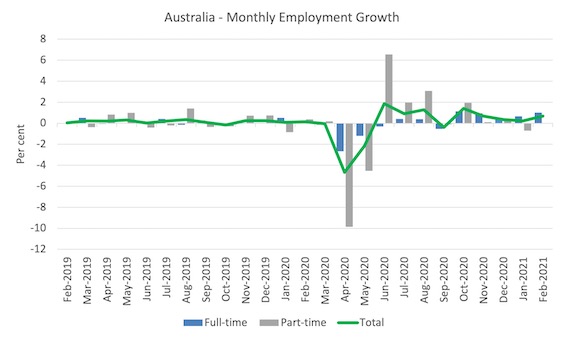
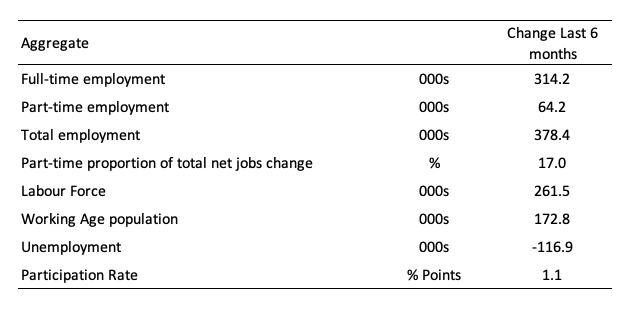
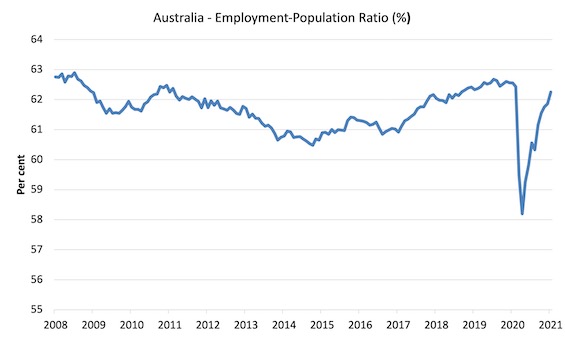
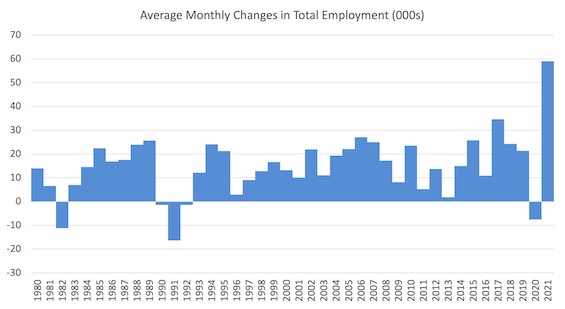
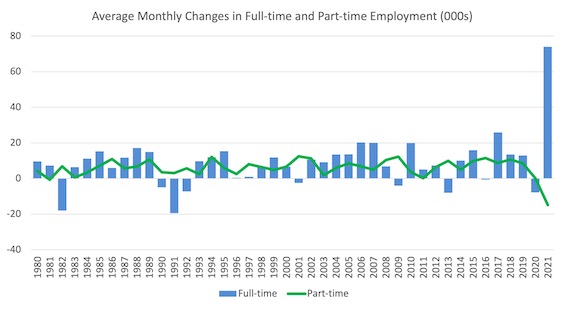
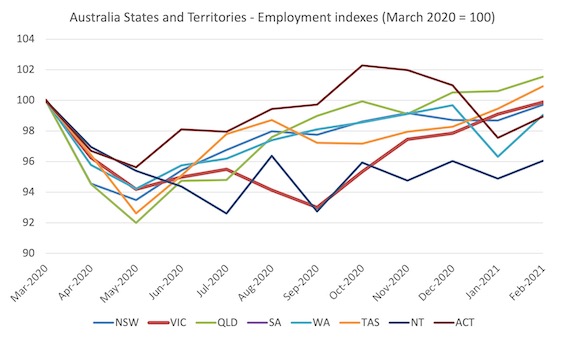
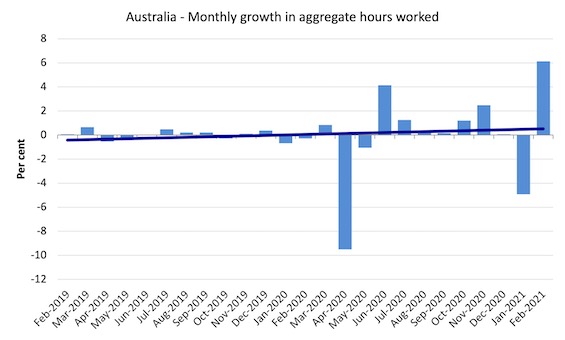
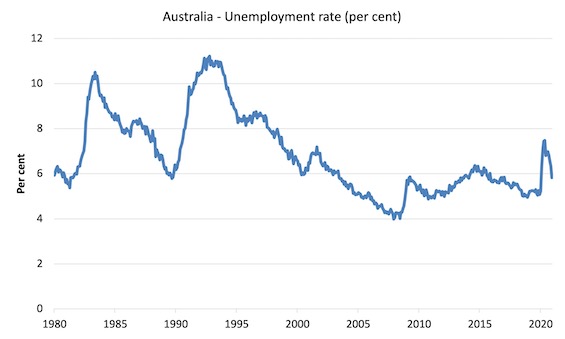
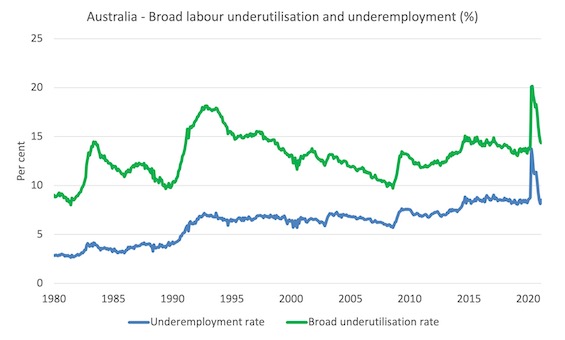
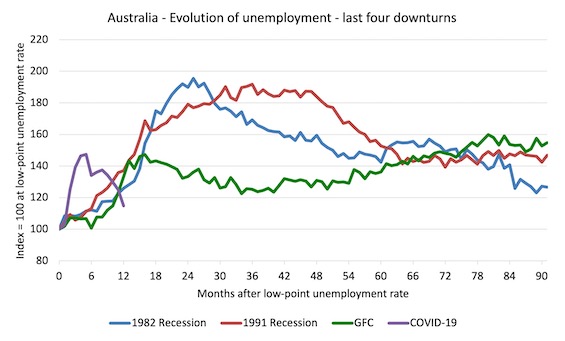
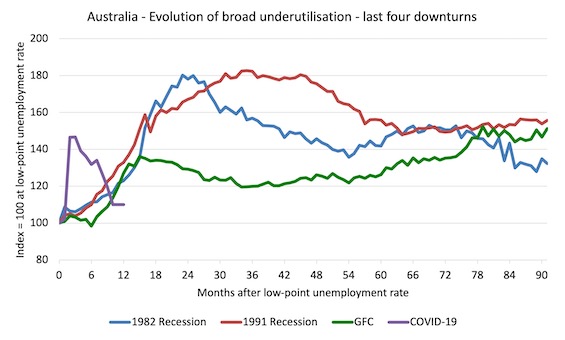
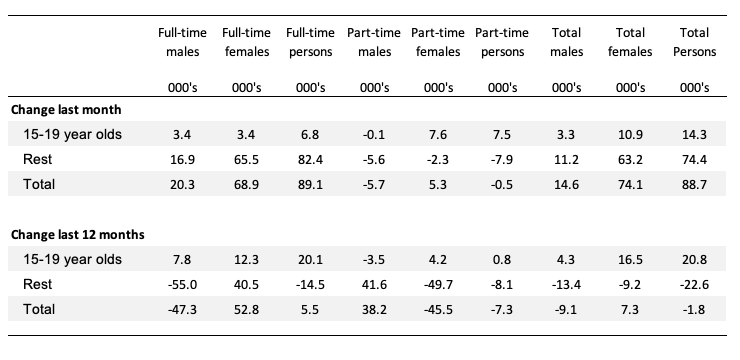

The *under-employment* graphs are significant; they are trending higher since 1980.
A JG would certainly help.
My area has yet to see any upswing in demand at all.
What I sell is a pure luxury item so it’s a bit of a barometer for how prosperous the population are (or are feeling) in general – demand soars in times of an economic boom that is widespread but quickly contracts when things soften. I noticed two short-lived spikes in demand immediately after each of the dates that early superannuation withdrawals were allowed but it’s been pretty slow aside from that.
The February labour market result is of course not possible to separate from the fact the money is still being pumped into the economy. When this winds up in a couple of weeks time – how long will other factors such as the new hyper-low interest rate regime and the high (or rather, historically-normal-sized) pool of household savings continue to drive activity for I wonder?
If counted as being employed means working one hour per week then government and their economists should be estatic if all were “fully” employed on that basis. As an old ragtrade expression goes “never mind the quality, feel the width”.
What an absurd and preposterous measure for society we have allowed to be made for ourselves.
No news from Bill for two days is not usual.
I hope everything’s fine with you.
Dear Paulo José Sousa Rodrigues (at 2021/03/20 at 10:07 pm)
Thanks for your kind enquiry. Yes, all is well. I have been travelling this week and routines a bit disrupted.
All the best
bill